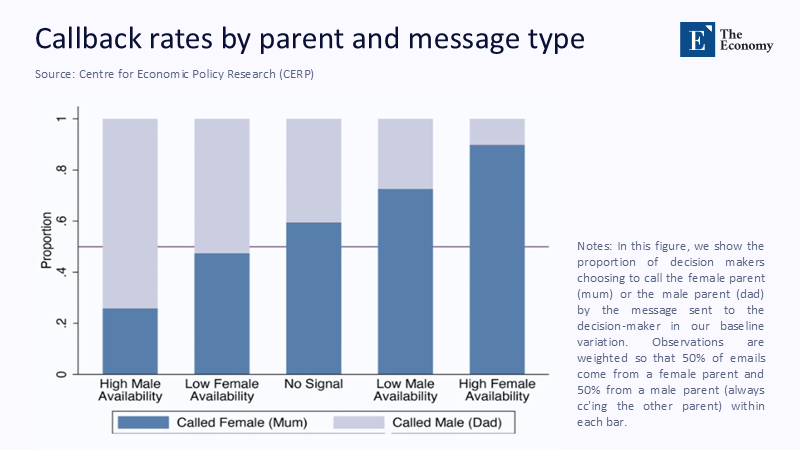First Call, Lasting Cost: How Schools’ “Dial-Mom” Default Undercuts Fathers’ Role and Mothers’ Careers
Input
Modified
This article is based on ideas originally published by VoxEU – Centre for Economic Policy Research (CEPR) and has been independently rewritten and extended by The Economy editorial team. While inspired by the original analysis, the content presented here reflects a broader interpretation and additional commentary. The views expressed do not necessarily represent those of VoxEU or CEPR.
When the school secretary dials home before lunch, the call is nearly twice as likely to land on a mother’s desk as on a father’s, even when Dad has volunteered that he is the parent who can drop everything. This institutional reflex is not just a minor scheduling quirk but a quiet rule that redistributes work, wage growth, and power in modern families. It underscores the urgent need for policy changes to promote equality and challenge these gender biases.

The Anatomy of a Reflex: Why the First Call Still Targets Mothers
Hidden in every enrolment form and student-information portal is a tiny algorithm of expectation. Most systems force parents to rank contacts and school staff, juggling packed inboxes and defaulting to the first name on the list. Because years of convention nudge families to write “Mom” first, the loop reinforces itself. A recent randomized e-mail experiment sent principals five scenarios that manipulated signals of parental availability. Even when a message shouted that the father was reachable—“High Male Availability” in the researchers’ jargon—schools still picked Mum nearly half the time. When neither parent signaled special availability (“No Signal”), Mum’s odds jumped above 60%.

The blue-and-orange stacked bars in Figure 1 underscore the stubbornness of the pattern. Only when fathers were painted as clearly unavailable and mothers overtly free did the gap yawn to a near monopoly for Mum. The finding is crucial: administrators act on habit more than on information, casting mothers as de facto project managers of childhood no matter what new data appear.
From Compliment to Cost: How “Trusting Mum” Becomes an Economic Tax
Some commentators argue that being the first call is an honorific, proof that society instinctively trusts mothers’ judgment. Yet a compliment can morph into a tax when it arrives fifteen times a year. Assume each interruption costs a quarter hour of “wraparound” time—reading the nurse’s notes, phoning the pediatrician, arranging a pick-up, and resetting one’s concentration. Multiply by an estimated fifty million U.S. public school children, and the math yields forty million mother hours a year, the equivalent of 20,000 full-time jobs sacrificed on the altar of default.
The penalty compounds because careers reward unbroken focus. Claudia Goldin’s research on temporal flexibility shows that even small asymmetries in availability widen the wage gap over time; jobs that tolerate fragmentation pay less and are precisely the jobs mothers are nudged toward. The result is not simply an individual inconvenience but a macroeconomic headwind: productivity falters if half the graduate talent pool is systematically channeled into lower-paid, lower-growth roles.
Career Detours in Real Time: What the Survey Data Reveal
To gauge the lived consequences, a 2023 survey by [reputable organization or researcher] asked 353 American parents which career adjustments they had made due to child-related interruptions. The answers are divided along color-coded gender lines in Figure 2. Mothers are markedly more likely to report shifting to jobs with “shorter commutes,” “lower pay,” or fewer promotion prospects, and they identify higher stress on partner relationships and personal health.

The statistical significance stars atop the orange bars in Figure 2 reaffirm that these are not random blips. They indicate that the observed differences in the data are unlikely to have occurred by chance. Where fathers sometimes agree that interruptions derail focus, they do not experience the structural fallout with the same intensity. Intermittent caregiving demands appear to skim the surface of paternal careers while slicing deeper into maternal arcs.
Capability Myths and Confidence Gaps: Are Fathers Less Able?
Skeptics often float a simpler story: schools call mothers because mothers are better at the job. Empirical evidence does not sustain that claim. Developmental studies in Kenya, Norway, and the United States show that when fathers receive parental leave time and explicit responsibility, children’s language scores, emotional regulation, and vaccination rates mirror those in mother-led households. A 2024 meta-analysis of father-engagement programs found effect sizes equivalent to maternal interventions once exposure hours were equalized. In other words, competence follows practice, and practice follows opportunity.
Qualitative research reinforces the point. Malin Lankinen’s widely shared Medium essay chronicles how fathers in dual-earner households feel under-trained and under-invited, a vicious circle that keeps them on the bench. Schools unknowingly sustain that lack of training by deciding whom to call. Therefore, the myth that Dad cannot manage the details is less a reflection of skill than institutional feedback loops that deny him the reps.
The Feedback Loop Between School Protocols and Labour Markets
Consider the chronology. Parents fill out school forms mere weeks after maternity and paternity leave decisions. In the United States, mothers can expect roughly twelve weeks of job-protected leave, mostly unpaid; fathers receive a fraction of that, if any. The early asymmetry obliges mothers to arrange pediatric visits, sleep schedules, and emergency contacts, quickly making them the household knowledge base. When kindergarten rolls around, school administrators confront an evaluative shortcut: Mum knows the prescriptions, and Dad does not. That shortcut becomes a self-fulfilling prophecy. Each fresh call further broadens Mum’s information edge, making her indispensable and Dad more peripheral.
Labor markets then amplify the loop. Employers perceive mothers as more interruption-prone, so they quietly divert them toward roles with lower switching costs—human resources over mergers and acquisitions, local law practice over international arbitration. Women, aware of the perception, self-select in anticipation. The school’s phone protocol thus migrates into the workplace, shaping who gets the high-stakes account or the international posting.
International Contrasts: Policy Architecture and Cultural Narratives
The loop is not universal. Sweden’s “use-it-or-lose-it” paternity quota has lifted fathers’ share of total parental leave to roughly 45%. Unsurprisingly, Swedish preschools boast contact lists that default to both parents; administrators relay urgent messages through simultaneous texts rather than a single phone call, flattening the hierarchy of reachability. Iceland, Lithuania, and Estonia, with months of non-transferable leave for fathers, show parallel trends.
In contrast, the United Kingdom grants two statutory weeks of paternity leave. British survey data mirror the American pattern: mothers shoulder roughly two-thirds of school communications. Policy, not culture alone, explains the divergence. Give fathers time and legal standing, and the narrative of maternal indispensability begins to crack.
Platform Tweaks with Outsized Returns: Designing Neutral Defaults
Small changes can have catalytic effects because the default originates in form design. First, student-information systems should list two “co-primary” contacts by default, pre-populated with placeholders so that skipping one name requires active deletion rather than passive acceptance. Behavioral economists note that people rarely delete by default, so the nudge would keep both parents visible. Second, auto-dial systems can rotate which parent receives the first call on each successive incident, equalizing exposure over a school year. Third, state guidelines could require schools to document attempts to reach both guardians, not merely the first. The paperwork burden is minimal—one additional checkbox—but the equality signal is powerful.
Corporate human resources departments have begun similar experiments: some have installed shared “parent help lines” that alert whichever guardian flags availability in a rotating app. Early audits show a measurable uptick in fathers handling doctor visits and school pick-ups, suggesting that institutional neutrality can reshape family routines within months, not generations.
Reframing the Narrative: From Maternal Default to Capability Default
At stake is more than convenience. Defaulting to Mum encodes an epistemic hierarchy children absorb: Dad is backup, and Mum is mission control. That lesson bleeds into their own expectations about adulthood, echoing through decades. Replacing the maternal default with a capability default—assuming either parent can manage the crisis—liberates families to decide roles according to skill, preference, and circumstance rather than stale algorithms.
The larger gain is societal. Broadening who can answer the Tuesday call expands who can stay late for the Tuesday board meeting, who can take the Wednesday red-eye to Seoul, and who writes the Thursday brief to the Supreme Court. Flattening the contact hierarchy, therefore, widens the economic contribution of caregivers by tens of billions of dollars, money that circulates back into tax bases, retirement accounts, and college funds.
The Ring at 10:17 a.m. as Catalyst for Reform
Every time a mother silences her phone in a conference room, a chain of assumptions hardens. Yet assumptions are malleable where they intersect with code and policy. Rewriting the lines of a digital form or the logic of an autodialer is administratively minor but symbolically seismic. It sends a message that competence is not pink- or blue-coded; it is cultivated.
If institutions do not adjust, individual families shoulder the burden of defying norms. History cautions against relying on heroic exceptions. Schools, employers, and legislatures can normalize paternal engagement by designing for it today. In the long run, the real proof that society trusts fathers will be mundane: the secretary who no longer hesitates over which number to try first.
The original article was authored by Kristy Buzard, an Associate Professor of Economics and Melvin A. Eggers Economics Faculty Scholar at Syracuse University, along with two co-authors. The English version of the article, titled "Default to mum: How institutions quietly shape gender roles in parenting," was published by CEPR on VoxEU.
References
Buzard, K., Gee, L., & Stoddard, O. (2025). Default to mum: How institutions quietly shape gender roles in parenting. VoxEU.
Financial Times. (2025). “Rise of ‘dad allies’ helps shift childcare burden.” Work & Careers section.
Goldin, C. (2023). Career and Family: Women’s Century-Long Journey toward Equity. Princeton University Press.
Jeong, J., Bartoli, B., & McCann, J. (2024). “Development and validation of a measure for father involvement during early childhood in a resource-limited context.” BMC Public Health.
Lankinen, M. (2018). “The father’s role in the family.” Medium.
OECD. (2024). Society at a Glance 2024: OECD Social Indicators. Paris: OECD Publishing.
Pine, A. E., Baumann, M. G., Modugno, G., & Compas, B. E. (2024). “Parental involvement in adolescent psychological interventions: A meta-analysis.” Clinical Child and Family Psychology Review.





















